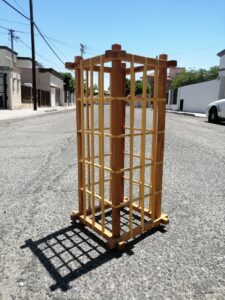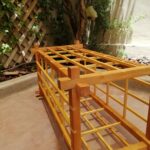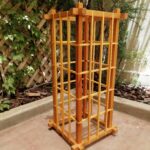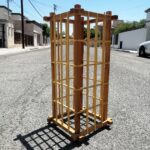Shoji Lamp Frame
Can’t hold me down ’cause you know I’m a fighter

By Herick Acosta
Japanese society was build with wood and skilled carpenters literally carved our current concepts of traditional Japanese aesthetics. Shoji lamps are a perfect representation of two traditional components in their society, rice and wood.
Shoji lamps are composed of a wooden frame and shoji paper (rice paper) shade panels. This could be considered a simplification of the traditional sliding doors or screens which are made with the same materials just slightly bigger.
This beautiful lamps are an essential part or traditional Japanese houses, which are characterized by tatami mat flooring, sliding doors, wooden beams and shoji screens.
The current impact of this simple but yet elegant lamp is that they instantly add a Japanese look to your interior and set a warm atmosphere in the room. This unique quality is the main reason I was attracted to the idea of creating my own Shoji Lamp … frame.

“Shoji lamps are composed of a wooden frame and shoji paper (rice paper) shade panels. (…) they instantly add a Japanese look to your interior and set a warm atmosphere in the room”
Traditionally, all of this was done with sharp chisels and a mallet but I was not ready for the full Japanese master woodworker experience and decided to use my not so trusted Chicago Electric 10″ table saw. I used this to cut both the 12 alder supports and the 28 pine stretchers. Pretty straight forward stuff.



The real work started when cutting all the single and double sided half lap joints. For this I created a very quick table saw sled that sped up the repetitive process.
Couple hours of work went by and all the parts were done. I knew the assemble was going to be critical for the final look and thankfully my lovely girlfriend offered to help me with all the gluing and we were able to assemble the frame in about two hours.
As you may see in the final product I opted to stack the pine stretchers rather than cutting lap joints in every intersection. I took this approach for two simple reasons, time and error avoidance. To be honest, leveled stretchers would have elevated the final look to a more traditional one but here is the caveat, only if done properly, otherwise it would have looked like a tangled piece of wood. Next time I will take that route and test my skills.
Another thing to point out is that Shoji Lamp Frame has no shoji paper panels and that is due to the lack of that material in my area. In the near future I will order some and create awesome projects with it.
Overall this was an awesome experience that quickly showed me the challenges of traditional joinery in which every piece needs to be the perfect size. I really liked the end result of this creation and the shadows that it casts are spectacular.
What do you think about it? Does this looks Japanese to you? Please let me know your thoughts and enjoy the clickable pictures below.




